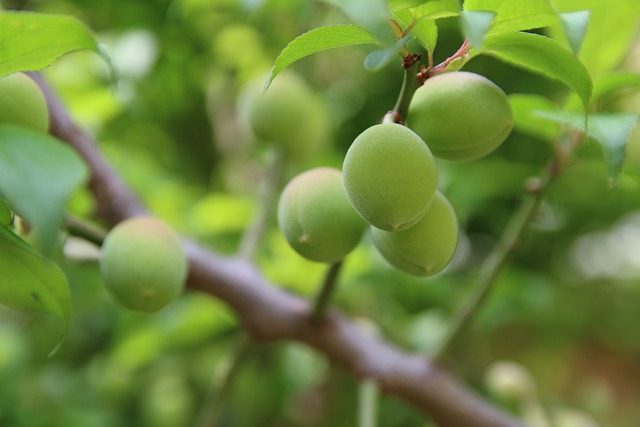
There is little more frustrating than planting a fruit tree, anxiously waiting for the first crop…and it never comes. This is a pretty common situation when growing peach trees at home. There can be a bit of a learning curve when it comes to troubleshooting fruiting problems. What may have gone wrong? Why are there no peaches growing on your peach tree?
A peach tree’s lack of fruit may be caused by age, cultivar selection, nutrient imbalance, or stress due to pests, diseases, weather, or other issues. Good cultural practices such as site selection, pruning, fertilizing, watering, and pest/disease prevention should benefit fruit production.
A lack of fruit is a peach tree’s way of signaling to you that something may be wrong. Observe your tree closely, take a look at the list below to determine what may be causing the problem, and see what you can do to help.
1. Too Young
Of all the fruit trees, peaches are one of the earliest to begin fruiting. It typically only takes 2 to 3 years for a new peach tree produce its first peaches. For those first few years, the tree is putting its energy toward establishing a root system and branch structure. Even if you get some fruit for a couple of years, a peach tree may not produce a robust crop until year 4 or 5.
How to Fix it:
If your young peach tree isn’t producing fruit yet, chances are you just need to wait. Make sure the tree is getting the water and nutrients it needs to establish a good growth habit. A healthier and more established tree will give you better peach harvests in the long run.
2. Too Old
On the other hand, as peach trees age they tend to lose their vigor. The fruiting wood grows more sparsely and higher on the tree, making crops smaller (and harder to reach). Commercial peach orchards may only keep their trees for 12-15 years, because after that the harvests become less robust and it’s harder to keep the tree small.
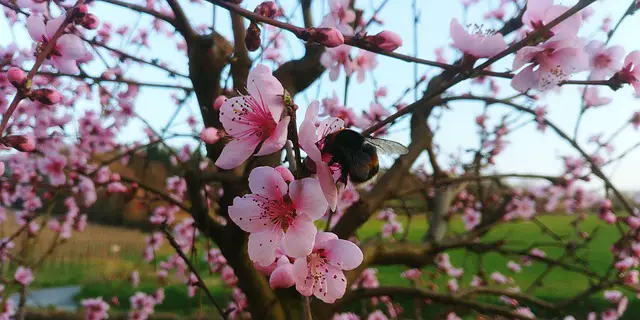
Backyard peach trees can happily last longer, though. A healthy, well-cared-for peach tree can grow and fruit for 15 to 20 years or more. But those harvests will decline in size (and possibly quality, too), as the tree gets older. Check out How Long Do Peach Trees Live and Bear Fruit? for more info.
How to Fix It:
If the peaches are still high-quality (and you can still reach them) then enjoy it! But if the peaches from the tree are small, few, or nonexistent, it may be time to say goodbye. Replace the tree with a new one and enjoy the cycle all over again.
2. Chill Hours
This is one of the most common reasons a peach tree might not fruit. Each peach variety requires a specific number of chill hours (the number of hours spent between 32° and 45°F) to produce fruit. Peach trees need a certain amount of time in dormancy before they know to wake up and start growing again.
If a peach tree receives fewer chill hours than it needs, then it may struggle to break dormancy and never blossom or fruit that season. If the number of chill hours is too high for your peach cultivar, then it may blossom too early and have its fruiting buds killed by frost – meaning no peaches that year.
How to Fix It:
It all starts when you purchase your peach tree. Each tree’s tag will show the number of chill hours that cultivar needs to produce fruit. Local nurseries will typically stock trees that have an appropriate number of chill hours for your area. (See my article here for more details about chill hours for peach trees, plus how to find out your area’s average chill hours.)
If you are buying a tree online, do some research to find out the average chill hours for your area. Note – this is different than your growing zone. The USDA growing zones only take into account the average lowest temperature for a location. Chill hours is the average amount of time spent at low temperatures, and can vary widely even in the same growing zone.
Even if you’ve chosen your peach tree wisely, with chill hours that correspond to your location, the winter weather will vary. Some winters will just be warmer or colder than usual, which means the peach tree may flower too early, too late, or not at all – producing no peach harvest that year. The good news is this doesn’t harm the tree, and next year’s crop may be better than ever.
3. Weather
This is another very common reason for a smaller-than-usual peach crop (or a nonexistent one). Peach buds (the little bumps on the tree that swell and open into blossoms) are very tender. One late frost can kill all of the new buds on a peach tree, decimating that year’s crop. Some buds may survive, or the tree may send out new buds, but it may be too late in the season.
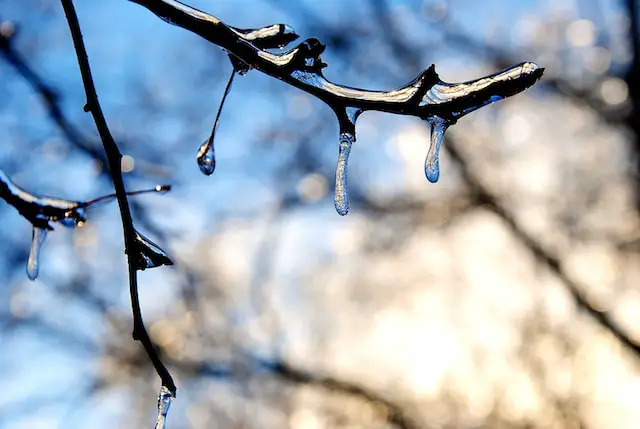
Unusually hot, dry weather could stress the tree and affect the peach crop as well. A drought-stressed tree goes into survival mode and may drop any young peaches so it can conserve its resources, rather than using all of its energy to ripen fruit.
How to Fix It:
Again, start by choosing the right cultivar for your climate. Some trees are more cold hardy or blossom later in the season, making them less susceptible to frost damage. ‘Reliance’, ‘Blushingstar’, and ‘Frost’ are all good cold-hardy peach varieties. (See The Best Peaches to Grow for Fresh Eating for more options.)
You can shelter peach trees from the cold by planting them in a sunny location near a wall or fence, where the sun reflects and traps a little more heat. Try wrapping the trunk with burlap or tree wrap tape to protect it from frost damage and sunburn. Mulch around the tree in the fall to insulate the roots.
Certain peaches tolerate heat and drought better, too. (See Growing Peach Trees in Hot Climates: What Do I Need to Know? to learn how to care for peach trees in the heat.) If your climate is hotter, consider choosing a peach that ripens earlier in the summer before the extreme heat begins. Some good options include ‘Desert Gold’, ‘Earligrande’, and ‘Flordaprince’. (You can find other good choices in The Best Low-Chill Peach Trees for Warm Climates).
4. Pruning
Pruning is an essential part of peach tree care and fruit production. If you forget to prune, the interior of the tree will probably be too shaded, keeping peaches from developing properly. An unpruned tree will produce less fruiting wood as it ages, meaning smaller and smaller peach harvests.
On the other hand, over-pruning can cause issues too. A peach tree that is pruned aggressively may overcompensate by growing too vigorously, leaving little energy for fruit production. Pruning at the wrong time of year (right before dormancy, say) could lead to frost damage and could affect the peach crop.
How to Fix It:
A moderate amount of pruning every year is the best way to keep a peach tree’s growth in check, reduce shading, and limit disease and pest stress. Pruning also maximizes fruit production and allows each peach to grow larger.
At the end of winter, right before bud swell, remove any dead, diseased, or crossing branches. You can also trim the top of the tree to keep it from growing too large. Water shoots (nonfruiting, small shoots that grow straight up from the branches) and root suckers should also be pruned.
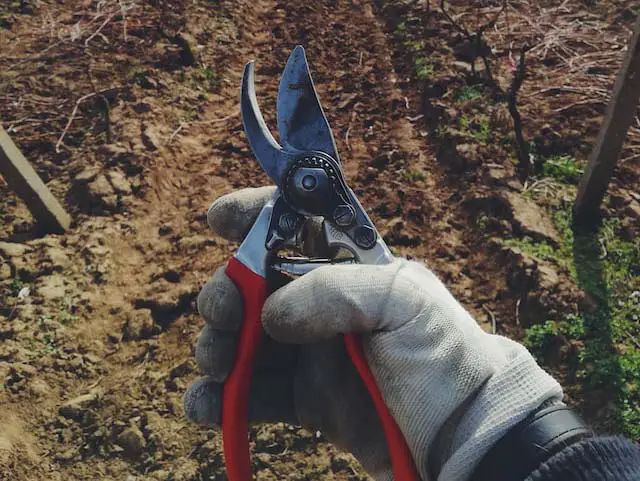
As the tree continues growing through the summer, lightly prune any twigs or branches that are heavily shading the ripening peaches. The goal is to remove about a third of the tree when it is dormant, then only lightly prune as necessary during the growing season.
Read A Simple Guide to Pruning Peach Trees for Maximum Harvest for full instructions on how to properly tackle this task – it’s simpler than it may seem.
5. Pests and Diseases
A peach tree may stop producing fruit if it’s under attack by pests or disease. Pests such as peach tree borers, scale insects, aphids, beetles, mites, and others can plague peach trees. A severe infestation will inhibit fruit production or even kill the tree in extreme cases.
Similarly, peach trees can fall victim to various diseases, including leaf curl, powdery mildew, brown rot, and bacterial spot. (Learn about treating peach leaf curl in Leaf Curl on Peach Trees: What It Is and How to Fix It.) Fungal or bacterial infection can weaken the tree over time and cause it to produce less fruit.
How to Fix It:
Discolored or distorted leaves, lesions on bark or fruit, and fruit or leaves falling prematurely can all be symptoms of infestation or infection. Read Dormant Peach Tree Spraying: What, When, and How to Do It for more information about how to prevent many diseases and pests.
Good cultural practices (soil health, pruning, watering, fertilizing, site selection, etc.) will keep a peach tree healthier and make it more resilient after pest or disease issues. Do everything you can to keep your tree happy, and it will have an easier time warding off problems.
Some areas have heavier disease and pest pressures than others, particularly in humid climates. It is common to have to spray peach trees both in dormancy and throughout the growing season to prevent these issues. There are many eco-friendly, organic options that can make a big difference.
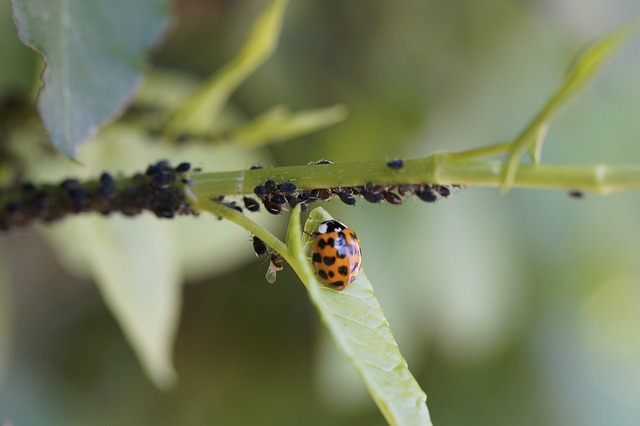
A basic peach tree spray schedule includes spraying with a copper fungicide and a horticultural oil in dormancy (before bud break) and spraying horticultural oil every week or so as needed throughout the growing season. A gentle natural oil, such as neem oil, can be sprayed right up until harvest.
Avoid any spraying while the blossoms are open so that pollinators aren’t harmed. Always follow product instructions and recommendations. When in doubt, ask at a local nursery or contact your county’s extension service to learn about specific pest and disease problems in your area.
6. Fertilizing
Believe it or not, the culprit here is usually too much fertilizing, specifically too much nitrogen. Fertilizers with a high concentration of nitrogen (the first of the three N-P-K numbers you see on the fertilizer bag) will encourage leafy growth, not fruit growth. This is a good thing in the early spring when the tree is coming out of dormancy, but less so later in the summer. If the tree’s energy is going to producing leaves and twigs, then it won’t have enough left to produce fruit.
You may not even be fertilizing the peach tree on purpose. Remember that lawn fertilizer you’ve been faithfully applying? Grass fertilizers are high in nitrogen, which is what makes the lawn green and lush. The fertilizer may seep down past the grass’s roots and be absorbed by the root of the peach tree or other plants.
A lack of nutrients may also affect the peach crop. As a peach tree matures, it may need a boost from fertilizer to provide the resources it needs to fruit. Like with many things in gardening (and life), finding the balance between too much and too little fertilizer is key.
How to Fix It:
Watch the tree during the growing season. A healthy tree should put on about 12-18 inches of new growth each year. If the new shoots are longer than that, less fertilizer may be needed. If the growth is shorter, then consider fertilizing the next spring.
In the early spring, choose a complete fertilizer that has a relatively balanced N-P-K ratio (nitrogen, phosphorus, potassium) – such as 10-10-10 – or one with a higher balance of nitrogen – such as 12-6-6. Apply it when you see blooms on the tree, right before or just as the petals begin to fall.
Mulch around the tree with compost once or twice a year to enhance the health of the soil. Compost will be broken down over time and will provide much needed micronutrients to the tree. The healthier the soil is, the healthier and more resilient the tree will be.
When you do fertilize your lawn, keep the fertilizer at least 6-8 feet away from the peach tree. The grass may be a little less lush in a ring around the tree, but then you will be able to control what added nutrients your peach tree is absorbing.
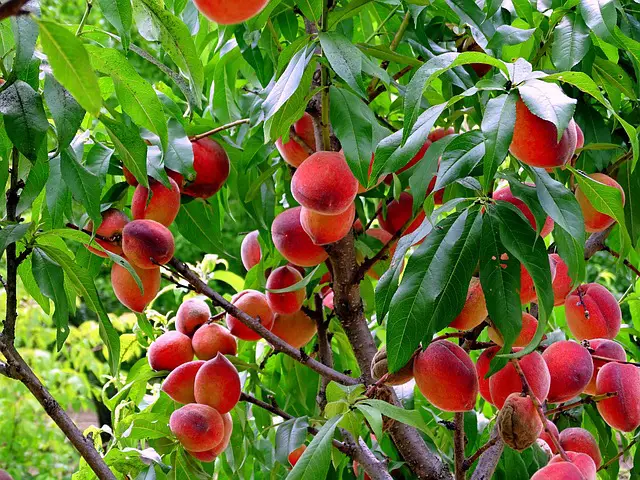
7. Heavy Harvest Last Year
A peach tree may have trouble setting fruit if last year’s crop was unusually large. If left unpruned, a peach tree may actually set more fruit than it can support every year. Often the tree will drop a number of young peaches so that it can ripen the remaining fruit.
But even so, the peach crop may be too large and could deplete the tree’s resources. As a result, during the next season the peach tree will need to spend its energy growing and recovering, rather than producing fruit.
How to Fix It:
The way to prevent this problem is by thinning the young fruit every year. When the peaches are still small, about 1/2 to 1 inch in diameter, remove enough fruit so that the remaining peaches are at least 6 to 8 inches apart.
You don’t need any tools to do this – simply pinch gently where the peach meets the branch. It may seem counterintuitive, but removing peaches will make the remaining ones grow bigger and sweeter. Thinning will also help the tree fruit more consistently every year, resulting in more peaches overall.
8. Pollination
Most peach trees are self-fertile, meaning they don’t need to be planted near another peach tree in order to produce fruit. The flowers of these trees can be pollinated by other flowers from the same tree. However, you may want to plant another tree of the same variety nearby, as this can increase the size of the peach crop even in self-pollinating trees.
But some varieties do need to be pollinated by another tree’s blossoms, which means another peach variety should be planted nearby. Some peach cultivars that require pollination include ‘Dwarf Frost’ and ‘Earlihale’.
How to Fix It:
If you find out your tree is one that needs to be pollinated, don’t despair. Plant another variety of peach tree within 100 feet, but make sure it’s a variety that blooms at the same time. The pollinators need access to the pollen and nectar of both sets of flowers.
What if you have no room for two peach trees? You can purchase a tree that has more than one variety grafted to it – meaning you get up to four varieties of peaches from one plant! You can also grow a dwarf peach tree in a pot to maximize space.

